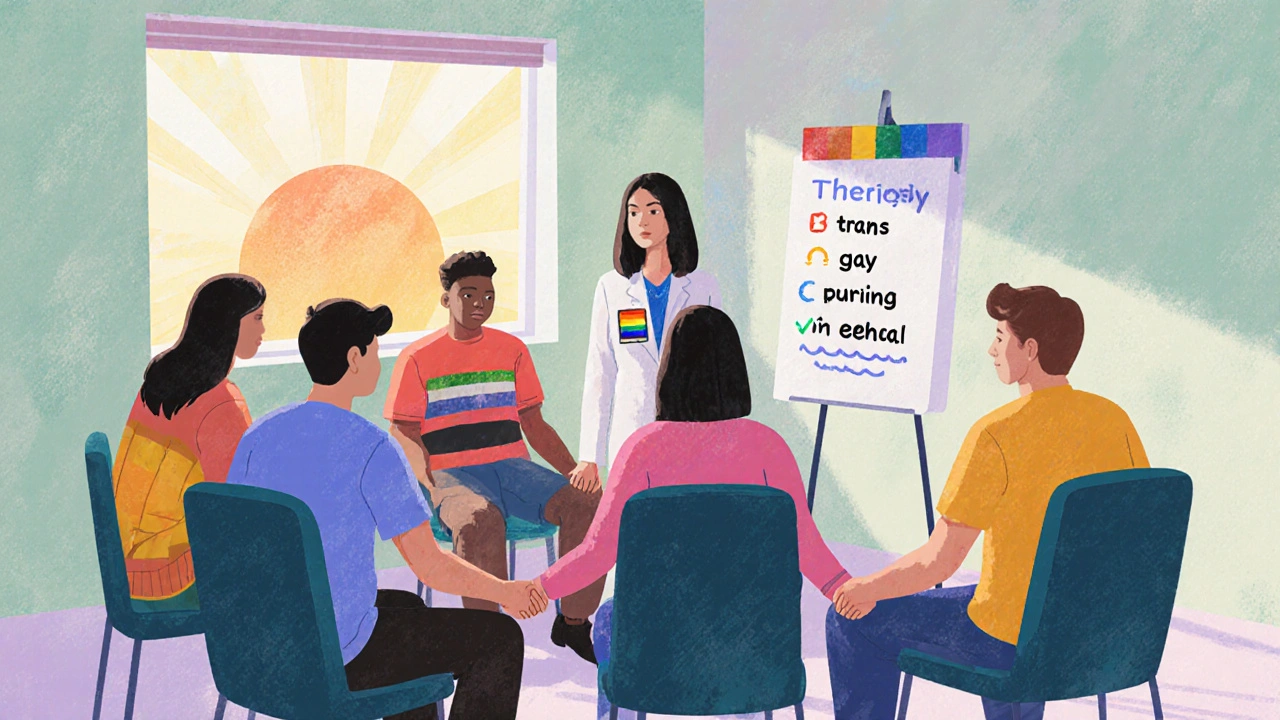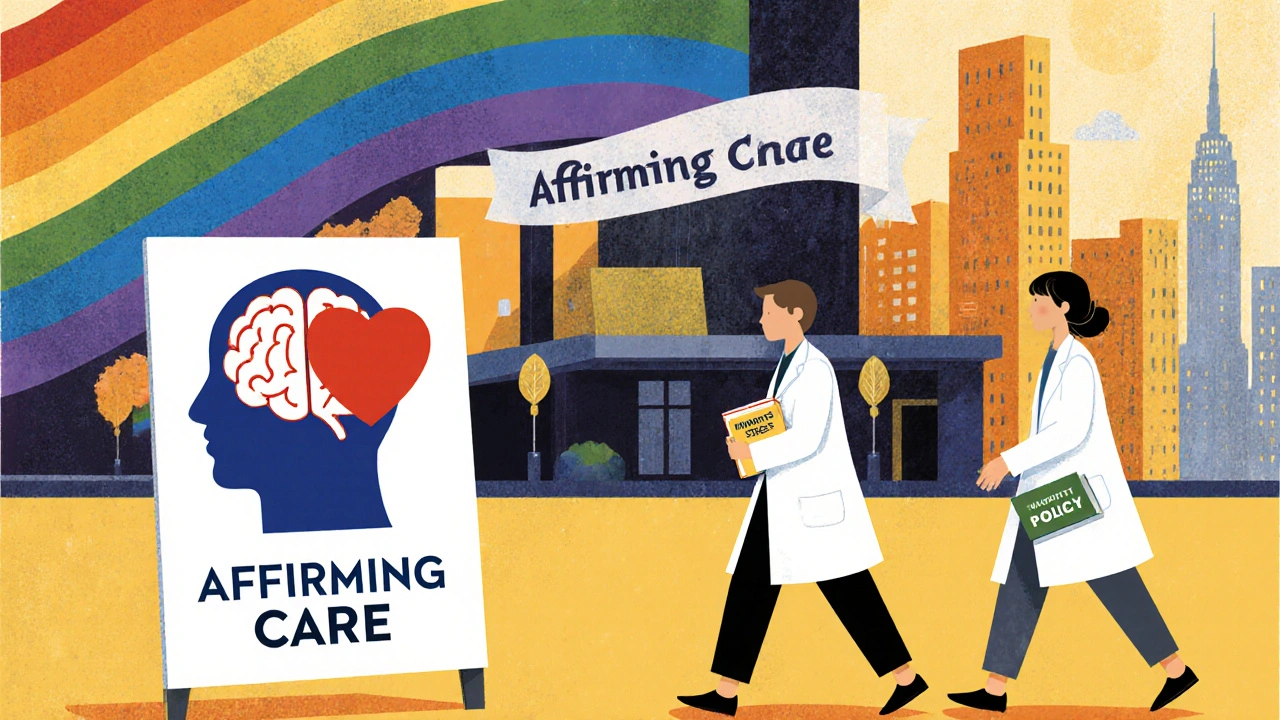Living with schizophrenia is already a tough ride, but for people who also identify as LGBTQ+, the road can get even more winding. This article breaks down why the overlap matters, the specific hurdles faced, and concrete ways to find help that actually works.
Key Takeaways
- LGBTQ+ individuals with schizophrenia often experience compounded stigma.
- Minority stress and medication side‑effects intersect, raising relapse risk.
- Tailored mental‑health services and peer support can dramatically improve outcomes.
- Family, clinicians, and community groups each have clear actions to take.
Schizophrenia is a chronic mental disorder marked by hallucinations, delusions, and disrupted thought patterns. It typically emerges in late adolescence or early adulthood, ages that often coincide with the period many people explore their sexual orientation or gender identity.
LGBTQ+ community refers to people who identify as lesbian, gay, bisexual, transgender, queer, or other non‑heteronormative orientations and gender identities. This community faces its own set of stressors-discrimination, family rejection, and social invisibility-that can amplify the symptoms of schizophrenia.
Why the Intersection Matters
Research from the Australian Institute of Health and Welfare (2023) shows that LGBTQ+ adults are up to three times more likely to be diagnosed with a psychotic disorder than straight, cisgender peers. The reason isn’t genetics; it’s the additive effect of minority stress the chronic pressure of navigating a hostile social environment on top of schizophrenia’s neurochemical challenges.
When both identities collide, two major forces shape daily life:
- External stigma: Discrimination from healthcare providers, employers, and even LGBTQ+ spaces that aren’t equipped to handle psychosis.
- Internalized stigma: Self‑shame that can fuel paranoia and worsen delusional thinking.
Unique Challenges Faced
Below is a quick snapshot of how challenges differ for LGBTQ+ people living with schizophrenia compared with the broader schizophrenia population.
| Challenge | General Schizophrenia Population | LGBTQ+ Population |
|---|---|---|
| Stigma | Mental‑illness stigma common | Dual stigma: mental illness + sexual/gender minority |
| Healthcare Access | d>Barriers due to symptom severity | Additional barriers: providers lack LGBTQ+ cultural competence |
| Medication Side‑Effects | Weight gain, sedation, metabolic syndrome | Hormone therapy interactions & heightened body‑image concerns |
| Social Support | Family or peer groups, often heteronormative | Potential family rejection; need for LGBTQ+‑affirming peer networks |
| Risk of Suicide | Elevated compared to general population | Even higher due to compounded minority stress |

Medication Considerations
Antipsychotic drugs are the backbone of schizophrenia treatment. However, for transgender patients on hormone replacement therapy, certain antipsychotic medication such as risperidone or olanzapine can interfere with estrogen or testosterone metabolism, potentially destabilizing both mental health and gender‑affirming goals.
Clinicians should:
- Conduct a thorough medication reconciliation that includes hormone dosages.
- Choose agents with lower metabolic risk (e.g., aripiprazole) when weight gain threatens body image.
- Monitor blood work every three months for lipid and glucose changes.
Therapeutic Approaches That Work
Standard psychotherapy for schizophrenia includes cognitive‑behavioral therapy for psychosis (CBTp) and social skills training. When paired with LGBTQ+ affirming care, these interventions become far more effective.
Key adaptations:
- Psychotherapy should explicitly address internalized homophobia or transphobia alongside hallucinations and delusions.
- Group therapy should be mixed‑identity-bringing together people with schizophrenia who also identify as LGBTQ+ to share coping strategies.
- Use gender‑neutral language and respect pronouns throughout sessions.
Building a Support Network
Support isn’t a one‑size‑fits‑all. Here’s a step‑by‑step plan anyone can follow:
- Identify affirming providers: Look for clinicians who list LGBTQ+ competency on their profiles (e.g., Gay and Lesbian Medical Association directory).
- Connect with peer groups: Organizations like Lifeline’s “Support for LGBTQ+ with Psychosis” (Sydney) or online forums such as “SchizoSpectrum LGBTQ+ Community”.
- Educate family: Share resources like “Understanding Schizophrenia for Parents of LGBTQ+ Youth” to reduce rejection.
- Create a crisis plan: Include hotline numbers (e.g., Lifeline 13 11 14), trusted friends, and a clear medication schedule.
Each of these actions reduces isolation-a core predictor of relapse. Research from the University of Melbourne (2024) found that participants who had at least one LGBTQ+‑affirming therapist were 40% less likely to be rehospitalized within a year.

Addressing Suicide Risk
Suicide is a tragic reality for many juggling both diagnoses. LGBTQ+ adults with schizophrenia have a suicide rate estimated at 45 per 100,000, compared with 14 per 100,000 in the general population.
Effective safeguards include:
- Routine use of the Columbia‑Suicide Severity Rating Scale (C‑SSRS) at every appointment.
- Safety contracts that specifically mention harassment or family rejection as triggers.
- Rapid access to crisis services that are LGBTQ+ knowledgeable-such as the Trans Lifeline (Phone: 877‑565‑8860).
Policy and Systemic Changes
On a broader level, change happens when health systems embed intersectional care into policy. Some promising moves:
- Australia’s National Mental Health Strategy (2025) now requires cultural competency training for all mental‑health staff, including LGBTQ+ modules.
- Medicare rebates for “affirming psychotherapy” introduced in 2024, making it easier for patients to afford specialized care.
- University of Sydney’s “Inclusive Psychiatry” curriculum teaches medical students how minority stress interacts with psychosis.
When these frameworks are in place, individual clinicians have the tools they need to deliver truly holistic treatment.
Frequently Asked Questions
Can antipsychotic medication affect hormone therapy for transgender patients?
Yes. Some antipsychotics impact liver enzymes that process estrogen or testosterone, potentially altering hormone levels. Doctors should monitor hormone panels regularly and may choose lower‑interaction drugs like aripiprazole.
What are safe places to find LGBTQ+‑affirming mental‑health support?
Start with national directories such as the Australian Psychological Society’s LGBTQ+ therapist list, local community health centers that advertise inclusive services, and online peer groups like “SchizoSpectrum LGBTQ+ Forum”.
How does minority stress worsen schizophrenia symptoms?
Chronic stress releases cortisol, which can amplify dopamine dysregulation-the core neurochemical issue in schizophrenia. This leads to more intense hallucinations, heightened paranoia, and poorer medication adherence.
Is psychotherapy effective for LGBTQ+ people with schizophrenia?
When therapy is explicitly LGBTQ+ affirming, outcomes improve dramatically-studies show a 30‑40% reduction in relapse rates compared to standard CBTp alone.
What should I do if I feel unsafe at a mental‑health appointment?
Immediately request a different clinician, contact the clinic’s patient‑advocate line, and consider reporting to the Australian Health Practitioner Regulation Agency if discrimination occurs.
Understanding the overlap between schizophrenia and LGBTQ+ identity isn’t just academic- it’s a lifesaver. By recognizing the unique hurdles, tailoring treatment, and building supportive networks, we can turn a daunting diagnosis into a manageable part of a fulfilling life.


Madhav Dasari
October 21, 2025 AT 00:40Yo, reading about the cross‑road of schizophrenia and queer identity is a reminder that we’ve got to build bridges, not walls.
When someone is juggling both, the stress multiplier can feel like a thunderstorm in their head, so having a safe space to vent is priceless.
Finding a therapist who gets both the neuro‑chemical side and the gender/sexuality side can be a game‑changer, and it’s worth hunting down even if it takes a few callbacks.
Don’t let the fear of stigma lock you out; community groups that blend psychosis support with LGBTQ+ affirmation exist, both online and in local hubs.
Keep pushing for that holistic care – the mind and the identity deserve the same love and respect.
DHARMENDER BHATHAVAR
October 22, 2025 AT 04:26It is imperative to integrate hormone level monitoring when prescribing antipsychotics to transgender patients, as drug interactions can destabilize treatment outcomes.
Clinicians should adopt standardized protocols that include endocrinological consultations alongside psychiatric evaluations.
Kevin Sheehan
October 22, 2025 AT 18:20The coexistence of schizophrenia and LGBTQ+ identity forces us to confront the very architecture of the self.
From a phenomenological standpoint, the brain's dysregulated dopamine pathways intersect painfully with the societal pressure of minority stress.
This collision is not merely additive; it creates a feedback loop where external discrimination amplifies internal psychotic distortion.
Imagine a mind already questioning reality, now tasked with navigating a world that constantly invalidates its core sense of belonging.
The resulting paranoia can be mistakenly read as pure symptomatology, when in fact it is a rational response to lived hostility.
Therefore, treatment must extend beyond medication compliance to include rigorous psychosocial safety planning.
Peer‑supported groups that affirm both mental health and gender/sexual identity serve as a buffer against that hostile feedback.
Moreover, clinicians should practice reflective humility, acknowledging that their own cultural blind spots may unintentionally reinforce stigma.
Evidence from recent Australian studies demonstrates a 40 % reduction in rehospitalization when affirmative psychotherapy is employed.
This statistic underscores the ethical imperative to train providers in intersectional competence.
On a neurochemical level, selecting antipsychotics with minimal metabolic burden, such as ariprazole, can mitigate body‑image concerns that are especially salient for queer patients.
Simultaneously, regular endocrine assessments ensure that hormone replacement therapy remains stable, preventing a cascade of physiological stressors.
The therapeutic alliance must also incorporate explicit discussions about internalized homophobia or transphobia, enabling patients to de‑escalate those internal dialogues.
In practice, this means setting aside dedicated session time to explore identity narratives alongside psychotic experiences.
When such an integrated approach is consistently applied, we witness not only symptom reduction but also a reclamation of agency.
Ultimately, the goal is to transform the lived experience from one of perpetual crisis to one of resilient self‑determination.
Jay Kay
October 23, 2025 AT 08:13Seriously, the double stigma is a nightmare nobody signed up for.
Jameson The Owl
October 24, 2025 AT 12:00What most people fail to see is that the pharmaceutical industry has long ignored the subtle hormonal pathways that intersect with mental health and the consequences are not isolated incidents but systemic failures that cascade through the healthcare system and patients are left to navigate a maze of specialists whose collaboration is often superficial at best and negligent at worst the solution lies in a coordinated policy framework that mandates interdisciplinary case reviews and enforces accountability for mismanagement only then can we hope to eliminate the hidden cost of untreated hormonal interactions in psychotic care.
Penny Reeves
October 25, 2025 AT 01:53The epistemic rigor of the discourse you presented is commendable yet falls short of addressing the ontological bifurcation inherent in identity‑pathology intersections; a more nuanced hermeneutic would interrogate the sociocultural scaffolding that sustains stigma rather than merely cataloguing clinical outcomes. Such an analysis elevates the conversation from pragmatic guidance to a theoretical synthesis worthy of scholarly citation.
Sunil Yathakula
October 25, 2025 AT 15:46Hey fam, i totally get how isolating it can feel when you’re dealing with both psychosis and the pressure of coming out – it’s like the world keeps throwing curveballs at you.
i’ve seen a few local groups that blend mental‑health support with queer safe spaces, and they’ve been a real lifeline for folks who feel invisible in mainstream therapy.
don’t be afraid to reach out, even if it feels scary at first, because having someone who “gets it” can make a huge difference in staying steady on your meds and feeling less alone.
dennis turcios
October 26, 2025 AT 18:33While community groups can indeed provide valuable peer support, it is essential to verify that facilitators possess appropriate clinical oversight to avoid reinforcing maladaptive coping strategies; otherwise, well‑intentioned gatherings may inadvertently delay professional intervention.